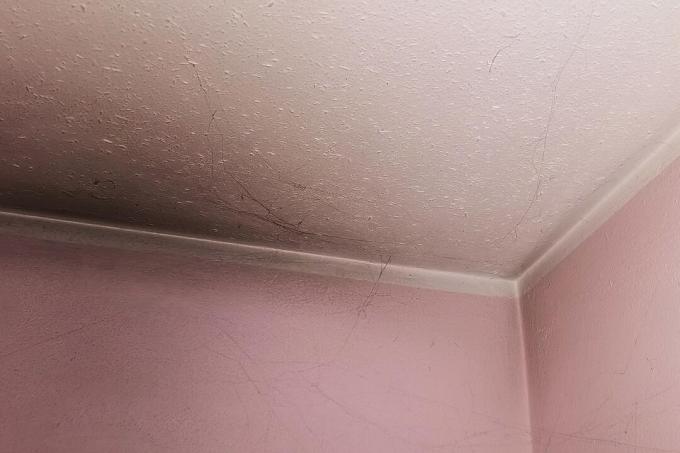

Table of contents
- What is fogging?
- Favorable Factors
- appearance
- Removed
- home textiles
- plastics
- walls
- prevent fogging
- ventilation and humidity
- candles and co.
- renovation works
- dust exposure and maintenance
- frequently asked Questions
Fogging is still a foreign concept to many, although black dust on walls, ceilings and carpets has been a widespread problem since the 1990s. We give all the important information about the tiresome topic from the emergence to the fight.
What is fogging?
The term fogging describes the deposit of black dust as an oily, greasy or sticky residue on living surfaces. The black dust seems to arise from a combination of evaporating plasticizers and dust and soot. However, the exact processes are still unclear.
However, the favorable factors for the formation of fogging have already been investigated.
Favorable Factors
The term fogging only came up in the mid-1990s because black dust suddenly became more common. It is found to a large extent in, but not limited to, new construction and post-renovation work.
With the accumulation of the phenomenon, it has been increasingly studied. The same factors came up again and again. These are:
- Occurrence during the heating season
- Use of plasticizers
- increased amount of dust
- missing or insufficient ventilation
- low humidity
- frequent use of candles, incense sticks or oil lamps
- stronger waterproofing of living quarters
- increased use of plastics
appearance
The black dust can be found on ceilings and walls, home textiles and plastic surfaces. As a rule, fogging occurs with the onset of the heating period. Typical are black stripes, which even appear on the carpet.
When fogging on walls or ceilings, the shock is often great, because at first glance the black dust is reminiscent of Mold. There are, however, some ways of distinguishing between the two phenomena.
- Mold smells musty, fogging doesn't smell
- Black dust suddenly appears Mold is slowly spreading
- Fogging occurs at low humidity, Mold at high humidity
- Black dust is sticky-greasy
Tip:
If you are unsure whether it is fogging, the area can be wiped with a clean, dry cloth. With black dust, greasy streaks form.
Removed
If fogging has already occurred, thorough removal must be carried out. Depending on the material in question, this varies in terms of both the procedure and the chances of success.

home textiles
Black dust is relatively easy to remove from washable home textiles such as curtains, blankets or pillowcases. As a rule, it is sufficient to use normal detergent. If black discolouration is still visible, stain removers against grease and soot can be used.
If the black dust is visible on carpets or upholstered furniture, the effort is greater. Upholstery cleaners and, if necessary, so-called spray extraction devices must be used here. In the case of carpets, a complete replacement may be necessary if the underside contains plasticizers.
plastics
When black dust settles on plastic furniture or other plastic items, cleaning is usually very easy. Normally, warm water, a sponge and a degreasing detergent are sufficient for removal. If this is not the case, special plastic cleaners are available.
Tip:
Fogging can also occur in the refrigerator or other cabinets. Thorough wiping is usually sufficient. The use of special kitchen cleaners is recommended, especially in the refrigerator or when it comes into contact with food.
walls
Fogging is very often first noticed on walls and ceilings. Responsible for this are the mostly considerable temperature differences. Since these are greatest in winter between exterior walls and heated interior spaces, the black dust mainly settles in these places.
Since degreasing detergent and warm water are required for cleaning, wallpaper can be damaged and paint can be wiped off.
An alternative to this is painting over. It is advisable to first apply a primer and paint over it while it is still wet.
prevent fogging
Whether black dust has already settled or fogging is to be prevented, a few simple measures can prevent the deposits.
ventilation and humidity
Black dust deposits mainly occur when there is insufficient ventilation. Even in winter, the room should therefore be aired several times a day. In order not to drop the room temperature too much, two to three minutes are sufficient.
This measure can already help to ensure that the humidity is not reduced too much. Due to the dry heating air, however, it is not yet sufficient. It also makes sense to bring indoor plants and use air humidifiers or air washers.
candles and co.

Candles, oil lamps, cigarettes or the table fireplace - black dust can be promoted by soot-forming influences. If you don't want to do without the atmospheric lighting, you should pay more attention to regular and sufficient ventilation.
renovation works
Fresh paint or new flooring - fogging often occurs after renovations. This is a good way of preventing black dust when selecting the means and materials to be used.
Products without plasticizers, preservatives and other non-volatile compounds are ideal. Natural materials are always to be preferred.
The timing of the renovation also plays a crucial role. Conducted in spring or summer, substances that could potentially lead to fogging can already evaporate before the heating period. Since the rooms are ventilated more frequently and longer during the warm seasons, the substances do not settle in the interior.
dust exposure and maintenance
Both a high level of soot and dust and frequent and very intensive maintenance of the apartment can promote fogging. At first glance, these states appear to be mutually exclusive.
In so-called "typical women's households", however, the conditions can coincide. Because they contain more home textiles and decorations. In addition, cosmetics, candles, oil lamps and the like are used more frequently. This increases the occurrence of dust and vapors.

Intensive care and cleaning of the apartment or house is in turn associated with cleaning agents, which also release particles into the air. Sufficient ventilation is therefore all the more important.
frequently asked Questions
With proper use of the apartment and the use of commercially available paints, wallpaper and floor coverings, the landlord can usually have the costs covered. This also applies if there are defects that lead to thermal bridges. Nevertheless, the necessary legal steps can take a long time.
So far there is no evidence that fogging is harmful to health. However, it should be borne in mind that the visible deposits are only a fraction of the substances dissolved in the air. The black dust is therefore always a sign that more ventilation should take place or that the air needs to be filtered.
Fogging can form within a few hours. Often, however, it only becomes apparent after a few days or weeks and especially after you have been away or when the heating season begins.
 Home editorial office
Home editorial office
Learn more about wall / wall

Have L-bricks placed: overview of prices / costs
Making slope fortifications or edging from L-stones is one of the more challenging real estate projects. While you can certainly build smaller fortifications yourself, large amounts of earth should be supported by specialist companies. We explain what to look out for and what costs to expect.

Nails for concrete walls: this is to be considered
In addition to screws and adhesives, the do-it-yourself repertoire also includes nails for the solid assembly and attachment of materials. Not every nail is suitable for every purpose. Choosing the right nail depends on various factors, such as the construction material of the support wall.

Interior plaster: how much plaster do you need per square meter?
If interior plaster is to be applied, one question above all arises: how much plaster do you need per square meter? Because too much material causes unnecessary costs. Too little plaster is annoying because it takes time and money to buy again.

Brick Wall: Remove plaster from bricks
Removing plaster from a brick wall takes effort and careful handling. Bricks are delicate and crack/break easily. Here sensitivity and the right instructions are required, which experts have created for hobby craftsmen and those who want to become one.

Drain house & masonry | Cost & Duration
Anyone who needs to have their house and masonry drained has a choice of different methods. We offer here how the costs can be, how long it can take and other important facts.

Calculate dew point on the wall | 5 information on dew point calculation
The dew point is an important tool, especially when insulating buildings. It indicates where the temperature is so low that water vapor condenses as moisture. For help with calculating how this value is determined, see the guide.
